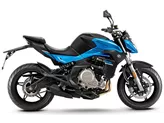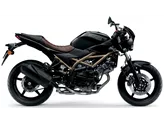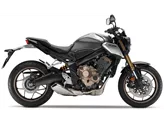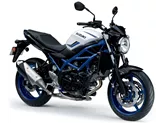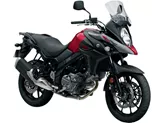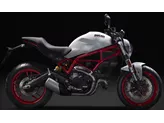Suzuki SV 650 2017 vs. Kawasaki Z650 2017

Suzuki SV 650 2017

Kawasaki Z650 2017
Overview - Suzuki SV 650 2017 vs Kawasaki Z650 2017
The Suzuki SV 650 2017 and the Kawasaki Z650 2017 are both naked bikes with similar technical specifications. However, there are some key differences between the two models.
In terms of engine and drive train, the Suzuki SV 650 2017 is equipped with a V-twin engine that produces 76 horsepower and 64 Nm of torque. On the other hand, the Kawasaki Z650 2017 has an in-line twin engine that delivers slightly less power at 68.2 horsepower, but slightly more torque at 65.7 Nm. Both bikes have fuel injection systems, liquid cooling, and 2 cylinders.
When it comes to suspension, both bikes feature telescopic forks in the front and swing arm suspension with a monoshock in the rear. The chassis of both bikes is made of steel and has a tubular frame. The front brakes on both models are double disk with a diameter of 290 mm for the Suzuki SV 650 2017 and 300 mm for the Kawasaki Z650 2017. The front brakes on both bikes also have double piston calipers. Both models come with ABS as an advanced rider assistance system.

Suzuki SV 650 2017
In terms of dimensions and weights, the Suzuki SV 650 2017 has a front tire width of 120 mm and a rear tire width of 160 mm, with both tires having a diameter of 17 inches. The wheelbase of the Suzuki SV 650 2017 is 1445 mm, and it has a seat height of 785 mm. The kerb weight of the Suzuki SV 650 2017 with ABS is 197 kg, and it has a fuel tank capacity of 13.8 liters.
On the other hand, the Kawasaki Z650 2017 has the same front and rear tire dimensions as the Suzuki SV 650 2017. However, it has a slightly shorter wheelbase of 1410 mm and a slightly higher seat height of 790 mm. The kerb weight of the Kawasaki Z650 2017 with ABS is 187.1 kg, and it has a larger fuel tank capacity of 15 liters.

Kawasaki Z650 2017
In terms of strengths, the Suzuki SV 650 2017 is praised for its smooth engine, playful handling, and great chassis. On the other hand, the Kawasaki Z650 2017 is known for its even power delivery, sporty chassis, and compact dimensions. One unique feature of the Kawasaki Z650 2017 is its negative display, which some riders may find appealing.
However, both bikes also have their weaknesses. The Suzuki SV 650 2017 is criticized for having weak brakes, which may be a concern for some riders. On the other hand, the Kawasaki Z650 2017 is said to be a little too small for tall people, which may affect the comfort of taller riders.
In conclusion, the Suzuki SV 650 2017 and the Kawasaki Z650 2017 are both solid options in the naked bike category. They have similar technical specifications, but each bike has its own strengths and weaknesses. Ultimately, the choice between the two will depend on the rider's preferences and priorities.
Technical Specifications Suzuki SV 650 2017 compared to Kawasaki Z650 2017
Pros and Cons in comparison
Pros and Cons in comparison
Suzuki SV 650 2017

The Suzuki SV 650 is accompanied by a long history of success that is sure to continue for a long time. Its supple V2 impresses with very smooth response and plenty of torque. Compact dimensions help to make the motorbike look very compact. This will be very convenient for beginners. The chassis also scores with playful handling. Unfortunately, the braking effect is not at the level one would expect from such a powerful vehicle.
Kawasaki Z650 2017

The Kawasaki Z 650 is the tip of the middle class for small male and female riders. On its compact dimensions, you probably won't feel comfortable as a giant. Heart-warming feelings, however, come from the engine, which delights with a very smooth pull. On the chassis side, a Kawasaki-typical tight set-up was chosen, which finds a great compromise in everyday use. The negative display is very easy to read and is reminiscent of its predecessor, the ER-6n - very nice!
Price Comparison Avarage Market Price Suzuki SV 650 vs Kawasaki Z650
There are a few key differences between a Suzuki SV 650 2017 and a Kawasaki Z650 2017. In terms of price, the actual average price of a Kawasaki Z650 2017 is about 4% higher. Compared to Kawasaki Z650 2017 there are less Suzuki SV 650 2017 bikes available on the 1000PS.de Marketplace, specifically 6 compared to 11. It takes less time to sell a Kawasaki Z650 with 76 days compared to 112 days for the Suzuki SV 650. Since model year 2005 1000PS.de editors have written 25 reviews for the Suzuki SV 650 and 31 reviews for the Kawasaki Z650 since model year 2017. The first review for the Suzuki SV 650 was published on 9/26/2008 and now has more than 14,200 views. This compares to more than 25,000 views for the first review on Kawasaki Z650 published on 11/8/2016.



